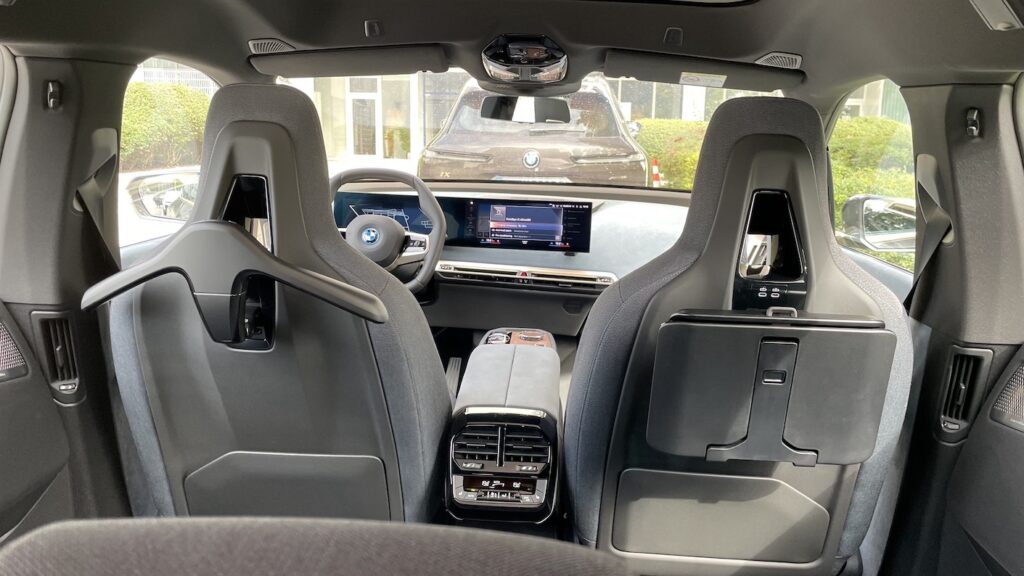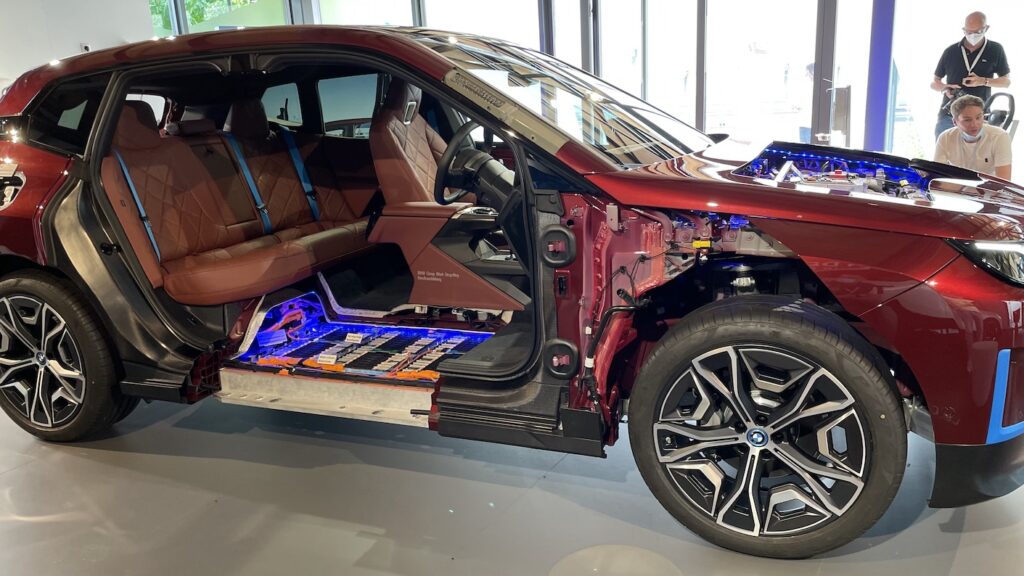01/10/2021 The brand-new iX is BMW Group’s technology flagship model that represents a significant transition for the premium brand. We went to Bavaria to test the five-seat car prior to its arrival in Ireland this November.

The all-wheel drive sports activity vehicle (SAV) is a showcase for the group’s future electric models as its construction method, powertrain and featured technology are all scalable. With a maximum range of up to 623 kilometres, excellent dynamic performance and rapid charging ability the iX is at the pinnacle of electric car design.

In the flesh the iX looks unremarkable with no particular head-turning appeal. In fact, some exterior styling elements like the contrasting gold door handles on our test car suggest European buyers might not be the prime target audience. Compared to an X5 the iX is slightly longer at 4953mm but narrower, lower to the ground and not as tall. Closer examination reveals an obsessive attention to flush surfacing and aerodynamic performance. The specially designed wheels are ultra drag efficient. 20-inch rims are standard and its 21 and 22 inch rims use Bridgestone tyres filled with acoustic foam to reduce noise. Speaking of noise, in the five seat cabin there isn’t any. The interior ambiance is incredible refined and whisper-quiet at all speeds, thanks to some lessons learned from BMW Group’s Rolls Royce.

The exterior design elephant in the room is BMW’s contentious front grille. Its styling is to many eyes, including guide dogs, is ugly. Thankfully the technology located behind it is beautiful, its high-tech too! Constructed of layers of special plastic, the smooth surface if scratched can heal itself. A direct heat source like a hairdryer or over time direct sunlight will heal the scratch. Behind the grille (that’s heated in cold weather) radar and camera technology help the iX in all manner of assisted driving and safety ways.

Armed with only an iPhone 12 as our key the test car unlocked once we were within a couple of metres of the car using the phone’s ultra-wideband radio technology. The spacious iX cabin sits inside a high-tech carbon cage frame. The interior and its layout impresses more than the exterior. Despite being all-wheel drive there is no transmission tunnel to trip over so access for all occupants is great. The iX features a dramatic homage to the latest Mercedes-Benz widescreen dash display, albeit curved in this case. he super wide display houses two screens, a 12.3 inch display for the driver’s instruments that can be read through the polygonal ‘kind-of-round’ steering wheel and a larger 14.9 inch display that displays everything else. The big display has all the usual interactive features like hand gesture activation and ‘Hey BMW’ voice connectivity. All the familiar swipe-able offline and online features we love like augmented reality navigation and smart phone integration etc. are available. I raised a smile from a BMW executive when I called the system Mercedes-Benz 2.0 – I’m available for bookings! BMW’s latest operating software IOS8 in installed in the iX. Using a unique BMW ID one can precondition the iX to activate a vast range of preferred setting remotely.

The centre console features an abundance of small soft touch, back-lit, flush-mounted areas/buttons that make conventional buttons look archaic. Our iX xDrive50 came with added sparkles. Expanding on the crystal bling switchgear introduced on X5 some years ago – our cabin had enough to shame a flagship Skoda concept car. If crystal or wood veneer is not your thing other trim options are available. In reality the driver’s head up display was really the most useful bit of technology. The cabin is a very comfortable place to be and we must recommend the iX’s seat massaging function that is capable of delivering a strong massage – I nearly had to say ‘go easy’ once! With a large glazed area and a full length sunroof the cabin is bright and airy. Lots of little details will raise a smile including the button you press to exit that is located where the handle would usually be.
The iX powertrain is impressive and extremely responsive. There are selectable driving modes that worked well with our air suspension equipped iX xDrive50 that facilitated an economical, sporty, comfortable or adaptive driving style. As with all BMW naming culture the bigger the number on the badge the more power the car has. The iX range starts with the 326hp/630nm iX xDrive40 model that has a maximum driving range from a full of 414km. Next is our test car the iX xDrive50 with 523hp/765nm with a maximum range of 623km. The iX xDrive60 range topper pushes out 600hp/1100nm. The M50 can sprint from 0-100kmh in 4.6 seconds. BMW’s all-wheel drive xDrive system uses dual motors with one on either axle and this delivers astounding traction thanks to new ‘near-actuator wheel slip limitation technology’. The iX can be driven with ease but it is capable of breath-taking performance that is always amplified in taller cars.

The xDrive’s electronics react remarkably quickly and we were blown away by the responsiveness under our right foot. As a general rule all electric cars deliver power quicker than petrol engines but the iX goes further and delivers its power better than most EVs. At any speed a quick poke of on the accelerator will see the iX leap forward with a grin-inducing enthusiasm. The motorway is the EV’s enemy as there is no chance of significant energy recuperation. High speed is not an issue in Ireland but in Germany the iX has to be able to comfortably do inter-city commuting. On the autobahn we reached our cars top speed of 200km/h with ease. Stability was good and the driving position gave a great view of the road ahead. Adaptive cruise control and level 2 autonomous driving functions in the iX were a great aid especially when simple cruising was required. All iX models leave the factory prepared for Level 3 automation in the medium term.

The iX features BMW’s fifth generation battery cell technology that packs a lot more punch. Its volumetric energy density at cell level is up by circa 40 per cent compared to the high-voltage battery in the 2020 BMW i3. The iX xDrive50 is fitted with a 111.5 kWh battery (105 kWh net), while the BMW iX xDrive40 gets a 71 kWh net battery (76.6 kWh gross).The battery in the 50 can rapid DC charge from 10-80% capacity in 35 minutes (at up to 195kW). The 40 does it in 31mins (at up to 150kW). All feature a CCS combo plug. The iX has an 11kW AC onboard charger. The iX combines an integrated heating and cooling system for the cabin with anticipatory thermal management for the battery. Its drive system operates using what BMW describes as ‘an exceptionally efficient heat pump function’.

On the road ‘adaptive’ brake energy recuperation (when selected) occurs with near spooky affect. The car notes where it is and reacts to the road layout and its topography, applying or releasing the brakes accordingly. You can also select B mode using the drive selector to have a one-pedal like driving experience. In certain circumstances the iX can freewheel or sail to reduce energy consumption. No rare earth metals feature in BMW’s newest electric motor fitted in the iX. The motor’s rotor (the spinning bit) does not utilise magnets like other EVs and this advance is significant and ultimately better for the planet. We took a tour of BMW Group’s Dingolfing plant where the iX is built to see the new electric motor and battery production line and also the rigorous testing each motor goes through. Dingolfing’s cars are built use green, mostly locally sourced hydro-electric power. BMW says it has secured ethically sourced cobalt and lithium from Australia and Morocco and that its aluminium is sourced from green energy suppliers that use solar power.

BMW says the iX is factory prepared to deliver the software systems of tomorrow. As a connected car with an inbuilt 5G data sim buyers will now and then be offered over the air updates that take circa 20 minutes to upload and install. Some will be free while others that release access to new driving or usage features will be available on a subscription basis. We pointed out to a senior BMW executive that a premium buyer should not have to be tapped twice with ‘functions on demand’ subscriptions. His counter argument said it will allow buyers access to a ‘premium’ vehicle at a lower base price and then the customer can choose whether to upgrade to further features. An example would be the hardware required for remote smart phone driving (accessing tight parking spaces from outside the car) will be already fitted in the car but the software to operate it will be subscription based.

In 2001 BMW revealed the i3 electric urban car at the Frankfurt motor show and it was a seminal moment in car design. Now some 20 years later the iX is launched and is just as significant. The iX is an outstanding car and proof of BMW’s commitment to an electric future. Ireland pricing starts from €85,815 (iX xDrive40 Sport). Michael Sheridan




